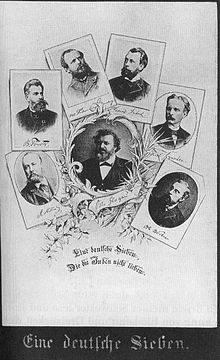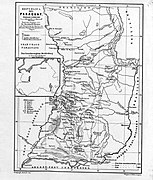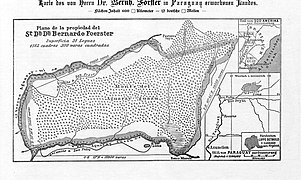Bernhard Foerster
Ludwig Bernhard Förster (born March 31, 1843 in Delitzsch , † June 3, 1889 in San Bernardino , Paraguay ) was a German high school teacher and political agitator. He was married to Elisabeth Nietzsche , the sister of the philosopher Friedrich Nietzsche .
Life
Bernhard Förster was the son of a pastor. His older brother Theodor Förster became superintendent in Naumburg and Halle and professor at the University of Halle. His younger brother Paul Förster was a high school professor.
Förster was an admirer of Richard Wagner and a radical anti-Semitic agitator. He was active as part of the “ Berlin Movement ” and as the initiator of the anti-Semite petition together with Max Liebermann von Sonnenberg , Ernst Henrici and his brother Paul Förster. In 1880 a fight with the Jewish factory owner Kantorowicz led to Förster's dismissal from school ( Kantorowicz affair ). In 1881 he founded the German People's Association together with Max Liebermann von Sonnenberg .

After the “Berlin Movement” was less successful than hoped, he emigrated to Paraguay in 1886 and founded the “ Neu-Germania ” settler colony with a group of German nationalists . As a goal he pursued the "purification and rebirth of mankind - thus also safeguarding human culture." With a few speeches about the "Judaization" of Germanness and the local culture, he was able to gather a handful of emigrants around him who were to reestablish the fatherland in 1886 set sail from Bremen via Montevideo and Asunción into the piece of land chosen by Förster during his travels from 1881 to 1883. The government of the South American landlocked state, which had almost bled to male residents after the " Triple Alliance War " against Argentina , Brazil and Uruguay , had offered him very advantageous conditions for his colonization, but on the condition that a fixed number of colonists be within a certain period of time to lure them to the new German colony in Paraguay. Förster's expectations of a brisk influx of new colonists from Germany were not fulfilled despite the constant propaganda of the helpers at home such as that of his brother, the theologian Paul Förster and the anti-Semitic publisher Theodor Fritsch from Leipzig , although the latter with the “South American Colonial News” for them Colony also launched and busily distributed its own propaganda brochure.
When the ailing tailor Julius Klingbeil from Antwerp appeared in Paraguay with a large group of German emigrants in 1888 , his capital, Förster, was at first very welcome, as the donations collected by the helpers in Germany were decreasing. After a short time, however, Klingbeil saw through the false promises Foerster and his wife had made. If he was enthusiastic about the descriptions of the climate and the culture of life in Förster's books, he had to find out on the spot that he was surrounded by wild animals and swarms of mosquitoes , that it was raining all the time and that little was left of the vegetarianism and abstinence from alcohol. Instead, Elisabeth Förster-Nietzsche demanded that Klingbeil's wife work for her in the house. The tailor bitterly left "New Germania" and traveled back to Europe, where he wrote the book Revelations about the Dr. Bernhard Förster's colony New Germania in Paraguay wrote. The work triggered outrage in the German colonial scene and led to the immediate drying up of the flow of capital to South America. Overwhelmed by the resulting problems and the increasingly rebellious colonists died forester in 1889 at the age of 46 years at a hotel in San Bernardino by suicide .
aftermath
After the fall of the Berlin Wall , the British journalist Ben Macintyre traveled to Weimar to do research there on Friedrich Nietzsche. He came across evidence of the colony in which he found himself in 1991. His travel report Forgotten Fatherland - in the footsteps of Elisabeth Nietzsche gives answers to many questions about "New Germania", emigration, the zeitgeist, anti-Semitism, Wagner and also about Friedrich Nietzsche and his sister. From this, the BBC , directed by Candida Pryce-Jones, made the documentary “Nietzsche's Little Sister. The career of a forger ”, which was broadcast in the German version in the regional programs in the 1990s.
After Förster's suicide, his widow Elisabeth staged her farewell from Paraguay and returned to Weimar to live with her brother, whom she closely accompanied until his death in 1900. After his death, she collected and alienated his writings, so that Nietzsche subsequently became the court philosopher of the National Socialists , although his convictions were contrary to their ideals. At her request, Hitler had a bag of German soil sent to him for Förster's grave in the jungle cemetery in Paraguay. The colony still exists today, around 200 people of German origin live in it, all of whom are related to one another, and there are eleven family names. The German doctor NN. Schubert from Munich has already noticed the first signs of genetic problems through inbreeding , so that the settlement threatens to face serious problems.
Publications
- as Ludovicus Bernardus Förster: Quaestionis de Platonis Phaedro Pars prior. Proefschrift Göttingen. Berolinensis (Berlin) 1869, OCLC 69431810 (dissertation University of Göttingen 1869).
- Treatises on history and politics by Wilhelm von Humboldt. In: Collection of major works in the field of history and politics. Part V. Berlin 1870.
- Richard Wagner as the founder of a German national style. Chemnitz 1880.
- The relation of modern Judaism to German art. Lecture, Berlin 1881.
- Vegetarianism as part of the social question. Hanover 1882.
- Parsifal echoes. All kinds of thoughts about German culture, science, art, society felt by several people. Leipzig 1883. (later title: Richard Wagner in its national significance and its effect on German cultural life. )
- German colonies in the upper Laplata area with special emphasis on Paraguay. Results of in-depth examinations, practical work and travel, 1883–1885. Naumburg a. P. 1886
- Olympia: a look at the general art and cultural historical value of the excavations at Alpheios. Hall 1886.
- On National Education: An Attempt. Leipzig 1886. Complete digitization of the HAAB Weimar
- A font for memory and justification. 1889.
- The German colony of New Germania in Paraguay. Call, conditions and advice for settlers. With map of the colony. Leipzig 1887.
- Elisabeth Förster-Nietzsche: Dr. Bernhard Förster's colony New Germania in Paraguay. Berlin 1891.
literature
- Annette Hein. There is a lot of "Hitler" in Wagner. Racism and anti-Semitic German ideology in the “Bayreuther Blätter” (1878–1938). Niemeyer, Tübingen 1996, ISBN 3-484-65113-X (= Conditio Judaica; 13).
- Julius Klingbeil: Revelations about the Dr. Bernhard Förster's settlement of New Germania in Paraguay. A contribution to the history of our current colonial aspirations; communicated based on personal experience. Leipzig 1889.
- Werner Kopacka. The settlers . Novel. Nymphenburger, Munich 1996. ISBN 3-485-00741-2 .
- Daniela Kraus: Bernhard and Elisabeth Försters Nueva Germania in Paraguay. An anti-Semitic utopia. Univ. Diss., Vienna 1999.
- Ben Macintyre: Forgotten Fatherland. The traces of Elisabeth Nietzsche. Reclam, Leipzig 1994. (= Reclam-Bibl .; 1510) ISBN 3-379-01510-5 .
- Andreas Meske: The PR for the colony of New Germania in the context of the German emigration to Paraguay. Mag.-Work. at the Institute for Journalism, Mainz 1999.
- Heinz Frederick Peters: Zarathustra's sister. Fritz and Lieschen Nietzsche - a German tragedy. Kindler, Munich 1983. ISBN 3-463-00857-2 .
- Erich Podach: Shaping around Nietzsche. With unpublished documents on the history of his life and work. Liechtenstein, Weimar 1931.
- Hannu Salmi: The addiction to the "Germanic ideal". Bernhard Förster as a pioneer of Wagnerianism. In: Journal of History. 6/1994, pp. 485-496.
- Massimo Ferrari Zumbini: The Roots of Evil. Founding years of anti-Semitism: From the Bismarckian era to Hitler. Klostermann, Frankfurt am Main 2003. ISBN 3-465-03222-5 .
- Daniela Kraus: Förster, Bernhard. In: Handbook of Antisemitism . Volume 2/1, 2009, p. 236f.
Web links
| personal data | |
|---|---|
| SURNAME | Förster, Bernhard |
| ALTERNATIVE NAMES | Förster, Ludwig Bernhard (full name) |
| BRIEF DESCRIPTION | German high school teacher and anti-Semitic agitator |
| DATE OF BIRTH | March 31, 1843 |
| PLACE OF BIRTH | Delitzsch |
| DATE OF DEATH | June 3, 1889 |
| Place of death | San Bernardino , Paraguay |



